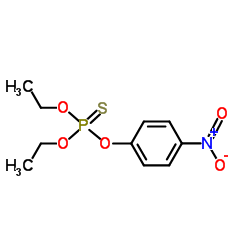Parathion

Parathion structure
|
Common Name | Parathion | ||
|---|---|---|---|---|
| CAS Number | 56-38-2 | Molecular Weight | 291.261 | |
| Density | 1.3±0.1 g/cm3 | Boiling Point | 375.0±0.0 °C at 760 mmHg | |
| Molecular Formula | C10H14NO5PS | Melting Point | 6.1°C | |
| MSDS | Chinese USA | Flash Point | 173.5±28.4 °C | |
| Symbol |




GHS02, GHS07, GHS08, GHS09 |
Signal Word | Danger | |
|
Haloalkylphosphorus hydrolases purified from Sphingomonas sp. strain TDK1 and Sphingobium sp. strain TCM1.
Appl. Environ. Microbiol. 80(18) , 5866-73, (2014) Phosphotriesterases catalyze the first step of organophosphorus triester degradation. The bacterial phosphotriesterases purified and characterized to date hydrolyze mainly aryl dialkyl phosphates, such as parathion, paraoxon, and chlorpyrifos. In this study, ... |
|
|
Chemometric assisted ultrasound leaching-solid phase extraction followed by dispersive-solidification liquid-liquid microextraction for determination of organophosphorus pesticides in soil samples.
Talanta 137 , 167-73, (2015) Ultrasound leaching-solid phase extraction (USL-SPE) followed by dispersive-solidification liquid-liquid microextraction (DSLLME) was developed for preconcentration and determination of organophosphorus pesticides (OPPs) in soil samples prior gas chromatograp... |
|
|
Preparation of parathion imprinted polymer beads and its applications in electrochemical sensing
Colloids Surf. B Biointerfaces 90 , 152-8, (2012) Graphical abstract |
|
|
Chemotaxis and degradation of organophosphate compound by a novel moderately thermo-halo tolerant Pseudomonas sp. strain BUR11: evidence for possible existence of two pathways for degradation.
PeerJ 3 , e1378, (2015) An organophosphate (OP) degrading chemotactic bacterial strain BUR11 isolated from an agricultural field was identified as a member of Pseudomonas genus on the basis of its 16S rRNA gene sequence. The strain could utilize parathion, chlorpyrifos and their maj... |
|
|
Ultra-high performance liquid chromatography-quadrupole time-of-flight mass spectrometry to identify contaminants in water: an insight on environmental forensics.
J. Chromatogr. A. 1345 , 86-97, (2014) Ultra-high pressure liquid chromatography-quadrupole time-of-flight mass spectrometry (UHPLC-QqTOF-MS) acquiring full scan MS data for quantification, and automatic data dependent information product ion spectra (IDA-MS/MS) without any predefinition of the io... |
|
|
Molecular ionization from carbon nanotube paper.
Angew. Chem. Int. Ed. Engl. 53(23) , 5936-40, (2014) Ambient ionization is achieved by spraying from a carbon nanotube (CNT)-impregnated paper surface under the influence of small voltages (≥3 V). Organic molecules give simple high-quality mass spectra without fragmentation in the positive or negative ion modes... |
|
|
Development of a more specific and accurate multiple reaction monitoring method based on GC-EI/MS/MS for simultaneously monitoring and determining 34 kinds of pesticides in Qianjinzhidai pills.
J. Chromatogr. B. Analyt. Technol. Biomed. Life Sci. 983-984 , 47-54, (2015) A rapid and accurate multi-residue method was developed for simultaneously monitoring and determining 34 kinds of pesticides by GC-EI/MS/MS, successfully applied in Qianjinzhidai pills. Precision, repeatability, stability, limit of detection (LOD), limit of q... |
|
|
Demonstration of spread-on peel-off consumer products for sampling surfaces contaminated with pesticides and chemical warfare agent signatures.
Forensic Sci. Int. 241 , 7-14, (2014) A terrorist attack using toxic chemicals is an international concern. The utility of rubber cement and latex body paint as spray-on/spread-on peel-off collection media for signatures attributable to pesticides and chemical warfare agents from interior buildin... |
|
|
Development of phage immuno-loop-mediated isothermal amplification assays for organophosphorus pesticides in agro-products.
Anal. Chem. 86(16) , 8441-7, (2014) Two immuno-loop-mediated isothermal amplification assays (iLAMP) were developed by using a phage-borne peptide that was isolated from a cyclic eight-peptide phage library. One assay was used to screen eight organophosphorus (OP) pesticides with limits of dete... |
|
|
An in vivo zebrafish screen identifies organophosphate antidotes with diverse mechanisms of action.
J. Biomol. Screen. 18(1) , 108-15, (2013) Organophosphates are a class of highly toxic chemicals that includes many pesticides and chemical weapons. Exposure to organophosphates, either through accidents or acts of terrorism, poses a significant risk to human health and safety. Existing antidotes, in... |